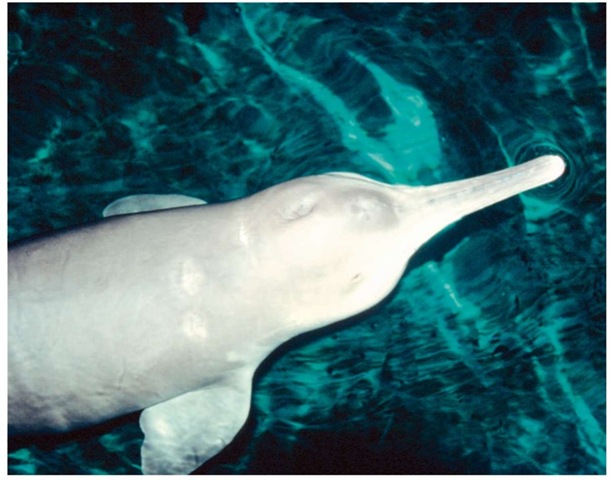Lipotes vexillifer
Phylum: Chordata
Class: Mammalia
Order: Cetacea
Family: Platanistidae
Status: Critically endangered,IUCN Endangered, ESA
Range: China

Dolphin, Chinese river
Lipotes vexillifer
Description and biology
The Chinese river dolphin, also known as baiji, is one of the most rare and endangered cetaceans (pronounced si-TAY-shuns; the order of aquatic mammals that includes whales, dolphins, and porpoises). It has an average overall length of 6.75 to 8.25 feet (2 to 2.5 meters) and weighs between 220 and 500 pounds (100 and 230 kilograms). Its body color is blue-gray on top and almost white underneath.
Chinese river dolphins have very poor eyesight, which is an evolutionary result of the muddy conditions of the water in which they live. Since the dolphins could not use their vision, they lost it over the course of time. The species adapted to this loss by developing the ability to use echolocation (sonar). In this process, the dolphin emits a sound wave that bounces off objects and is echoed or reflected back to the dolphin. Like bats, Chinese river dolphins use echolocation to navigate and to find prey.

Chinese river dolphins have very poor eyesight, which is an evolutionary result of the muddy conditions of the water in which they live. Dolphins adapted by developing the ability to use echolocation (sonar) to navigate and to find prey.
The dolphins usually travel in pairs or in groups of up to ten. The mating season for Chinese river dolphins occurs between March and May and again between August and October. A female dolphin gives birth to a single calf after a gestation (pregnancy) period of 10 to 11 months. During its first year, the young dolphin may swim behind its mother or the mother may carry it with her flipper.
Habitat and current distribution
Chinese river dolphins are found only in the Changjiang (Yangtze River) in China. They inhabit the middle and lower reaches of the main river and often congregate where fish gather, such as around sandbanks or where tributaries and lakes connect to the main river. Scientists estimate that the entire population of Chinese river dolphins is less than 200.
DID YOU KNOW?
On August 8, 1997, the Beijing Natural History Museum opened the world’s first major museum exhibition on the Chinese River dolphin. Baiji: Treasure in the Yangtze River featured slide programs, puppet shows, and media news stories on the plight of the baiji and the deteriorating conditions of the Yangtze River. The exhibition ran for three months, then traveled to museums in other Chinese cities throughout 1998. The baiji exhibit was to be the first in a yearly series of endangered species exhibits sponsored by the Beijing museum.
History and conservation measures
Many factors have led to the current critically endangered status of the Chinese river dolphin. Fishermen on the Changjiang often try to snag bottom-feeding fish by dragging hooks along the river’s bottom. This illegal fishing method accounts for about one-half of the known Chinese river dolphin deaths. Other dolphins are killed by boat propellers, especially in the lower region of the river where boat traffic is dense. A number of dolphins are killed when construction crews use explosives to build dams along the river. When built, dams and other barriers on the Changjiang destroy the dolphins’ habitat and food sources, leading to further deaths.
Since the late 1970s, the Chinese government has tried to protect the Chinese river dolphin. Programs are being developed to establish reserve areas on the river where fishing and fast boat traffic would be prohibited. Unless drastic conservation measures are taken, however, the Chinese river dolphin will become extinct in the wild.
Habitat and current distribution
African wild dogs are found throughout Africa south of the Sahara Desert. The animals prefer to inhabit grasslands, savannas, or open woodlands. Biologists (people who study living organisms) estimate that about 5,000 African wild dogs currently exist in the world.
History and conservation measures
African wild dogs were once common throughout the African continent. At the beginning of the twentieth century, packs of 100 or more dogs roamed the Serengeti Plain in northern Tanzania. Today, the total number of African wild dogs on the Serengeti is fewer than 60.
As the human population in Africa has grown, wild dog habitat has decreased. The animals have also suffered because of the widespread—but unfounded—belief they are pests. In many areas in Africa, people have shot, poisoned, and trapped them. The greatest threat to African wild dogs, however, is increased contact with domestic dogs. Canine diseases such as distemper and rabies run rampant when introduced into an African wild dog pack.
The breeding of African wild dogs in zoos has been moderately successful.
